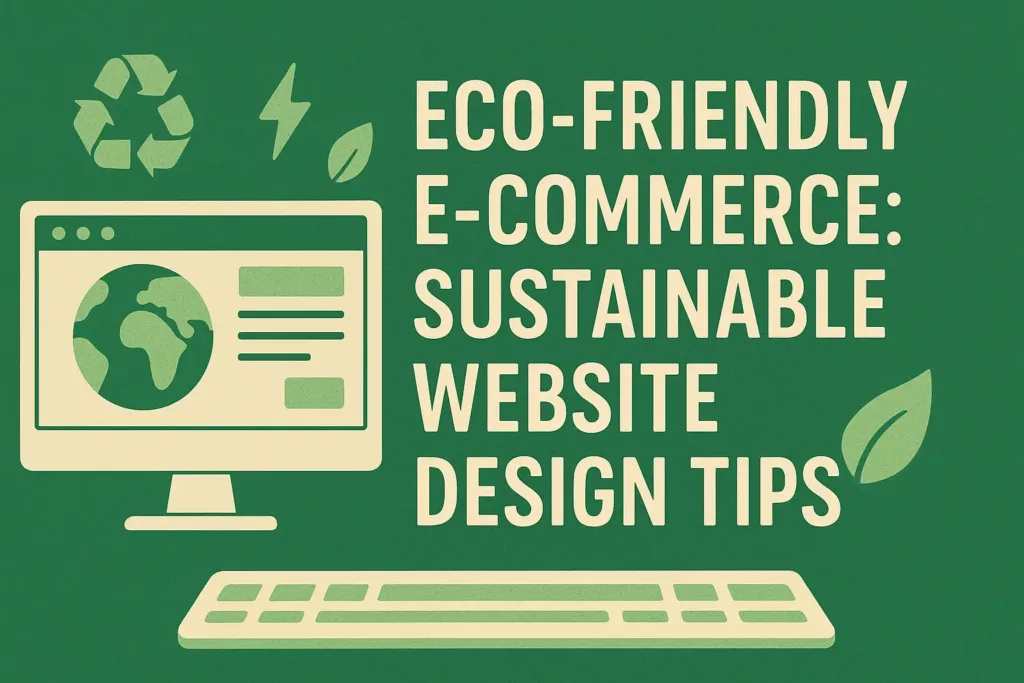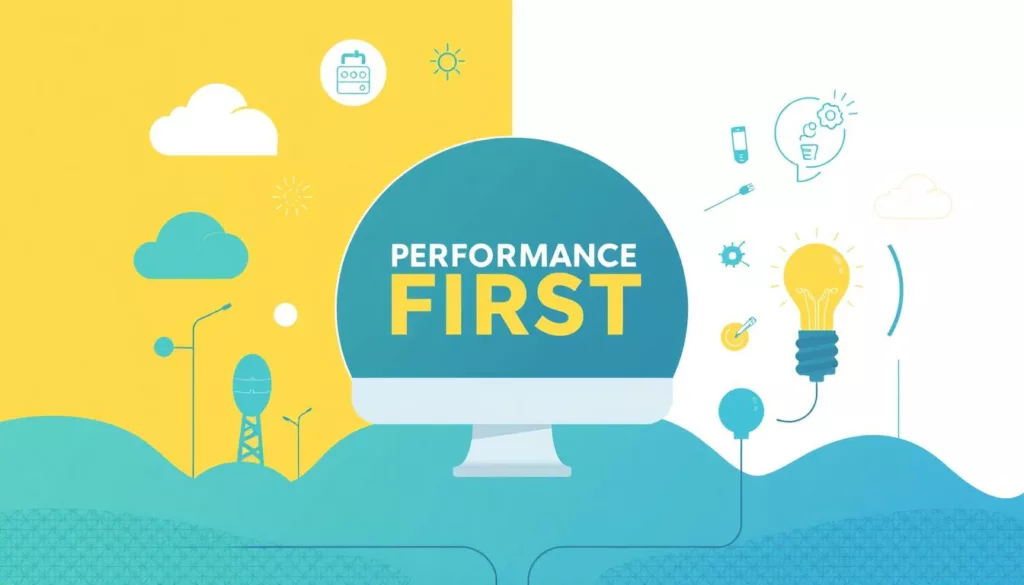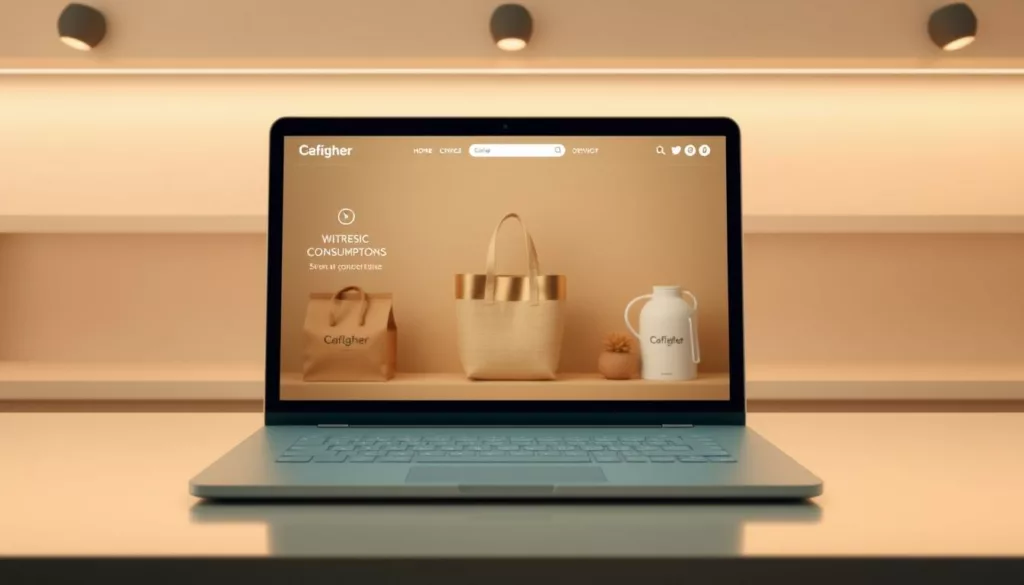
Creating lighter, faster online stores blends simple visual choices with performance work to lower digital energy use and boost conversion. This intro explains why a lean approach to sustainable e-commerce website design matters for user trust and long-term loyalty in the U.S. market.
Lightweight sites use less electricity, load faster, and serve more people on slow connections. In 2020, ICT made about 1.4% of global GHG emissions and the internet used roughly 4% of world electricity. Toolkits like Website Carbon Calculator, Ecograder, and Website Grader help teams measure page weight and carbon per view.
This guide shares best practices from measurement and performance-first UX to infrastructure choices, media optimization, SEO alignment, and governance. The goal is clear: lower environmental impact while creating a better, faster, and more inclusive shopping experience.
Brands and businesses gain by cutting hosting and bandwidth costs, improving speed, and widening reach. Aligning sustainability with values can also sharpen brand positioning and make purpose-driven storytelling more credible.
Key Takeaways
- Lean sites reduce energy use and improve user experience.
- Measure baseline metrics with Website Carbon Calculator, Ecograder, and Website Grader.
- Performance-first UX and media optimization cut page weight and costs.
- Faster pages build trust and help brand loyalty in the U.S. market.
- Governance and clear values make efficiency a competitive edge.
Why sustainable e-commerce matters now for U.S. businesses
U.S. retailers face a rising digital footprint as heavier pages and growing data centers push energy use and costs higher. Small performance wins now lower carbon and improve core metrics like load time, bounce rate, and conversion.
Today’s digital footprint
Fact: ICT made about 1.4% of global GHG emissions in 2020. U.S. data centers used roughly 4.4% of national electricity in 2023, up from 1.9% in 2018.
| Metric | Recent value | Why it matters |
|---|---|---|
| Median desktop page weight | ~2.68 MB (Jan 2025) | Higher transfer = more energy per page |
| Data center use (U.S.) | 4.4% electricity (2023) | More power drives costs and emissions |
| ICT emissions | 1.4% global (2020) | Digital choices affect the environment |
Brand, UX, and cost advantages
Shrinking page sizes speeds experience and reduces bounce. That lifts trust and conversion for any brand selling online across the U.S.
“Faster pages are better for customers — and for the planet.”
- Lower energy and bandwidth cut hosting bills and server load.
- Better UX reduces abandonment and returns.
- Transparent action strengthens reputation with consumers and investors.
Real examples show this is practical: lean assets, efficient hosting, and performance-first choices drive growth and cut environmental impact.
Start with measurement: audit the carbon and performance impact of your site
Before you change anything, collect data. Run audited checks to see which pages cost the most in energy and slow the experience for users. A clear baseline makes future gains measurable and credible.
Using audit tools to set a baseline
Begin with the Website Carbon Calculator for a quick carbon-per-view estimate and a public badge that signals progress.
Follow up with Ecograder to get a line-by-line review that highlights duplicate scripts, heavy media, and optimization opportunities.
Pull page size and core metrics from Website Grader to track weight reductions and aim below the global median of ~2.68 MB.
Reading results and benchmarking priority pages
Focus audits on PDPs, cart, and checkout since they drive revenue and often carry the largest media and scripts.
- Read metrics in context: watch page weight, energy intensity, data center sources, and accessibility scores.
- Set targets: capture before screenshots and set quarterly goals for performance and carbon reduction.
- Collaborate: encourage designers and developers to share an audit dashboard so code and content choices align with your improvement strategy.
Performance-first principles that lower energy usage and improve user experience

Make speed the default: lean layouts, limited assets, and clear priorities cut transfer and CPU time. That reduces energy per view and helps people complete tasks faster.
Mobile-first, lean layouts, and fast load times as green UX/UI
Prioritize mobile-first layouts with minimal blocking resources to shrink the initial payload. Faster first paint improves perceived speed and conversion on narrow networks.
Accessible, empathetic design: typography, color contrast, and device constraints
Choose readable type and strong contrast so content works on older screens and low-bandwidth connections. This reduces wasted reloads and frustrated users.
Clean code and fewer dependencies: fonts, subsetting, and script reduction
Limit font families and subset character sets. Cut JavaScript where possible, defer non-critical scripts, and drop unneeded third-party elements.
- Lazy load below-the-fold media to lower initial transfer.
- Use semantic HTML and lightweight CSS to speed rendering.
- Set performance budgets and enforce them in CI to prevent regressions.
“Faster pages are better for customers — and for the planet.”
Green infrastructure choices: hosting, CDN, and caching that cut emissions
Where you run your service and how you cache assets shapes both speed and emissions. Choose hosts that publish clear energy sourcing and use renewables. Locating primary hosting near your biggest U.S. user clusters reduces transmission distance and lowers carbon intensity.
CDNs and caching push assets closer to users. Use regional CDNs, edge caching, and browser rules so HTML, CSS/JS, and media are served locally. This cuts repeat transfers and reduces overall energy usage.
Practical configuration tips
- Pick renewable-powered hosts that publish data center sourcing and commitments.
- Enable HTTP/3, Brotli compression, and image optimization at the CDN edge.
- Set strong cache-control headers and use server-side and edge caching for heavy assets.
- Monitor origin egress, CDN hit ratio, and TTFB to confirm lower latency and fewer transfers.
- Plan multi-region failover that avoids duplicating large media unnecessarily.
“Placing content where users are reduces latency, saves energy, and improves conversion.”
| Choice | Benefit | Metric to watch |
|---|---|---|
| Renewable-powered host | Lower emissions and clearer reporting | Energy sourcing % / provider transparency |
| Regional CDN | Faster delivery and reduced transfer distance | CDN hit ratio / TTFB |
| Edge & browser caching | Fewer repeat downloads and lower server load | Cache hit rate / origin egress |
Finally, audit third-party services and remove unused integrations. Trimming slow or redundant scripts cuts background requests and lowers both energy and delivery costs. That makes your site faster and kinder to the grid.
Media-light experiences: optimize images, videos, and animations without hurting your brand

A media-first audit starts by measuring which files weigh down a page and which ones actually help conversion.
Images: convert to WebP or AVIF, serve responsive srcsets, and compress with perceptual settings. Set max display dimensions so files match the layout. Lazy load images below the fold and defer carousels until interaction.
Video choices that save bandwidth
Ask if a video adds value. When needed, compress, limit resolution, and use short loops. Prefer third-party players that adapt streams by device to lower transfer and CPU usage.
Motion done with care
Keep animations subtle and purposeful. Honor prefers-reduced-motion and set strict motion budgets so scripts do not spin GPU or CPU unnecessarily.
- Convert and serve modern formats to avoid oversize visuals.
- Compress aggressively while preserving brand quality.
- Lazy load and defer non-critical media assets.
- Purge stale assets from CMS and CDN regularly.
| Media type | Best practice | Key metric |
|---|---|---|
| Images | WebP/AVIF, responsive srcsets, lazy load | KB per visible image |
| Video | Compress, cap resolution, embed optimized player | Average bitrate / load time |
| Animations | Respect reduced-motion, set performance budget | CPU/GPU time per interaction |
“Optimized media keeps pages fast and preserves visual identity.”
SEO and sustainability: the win-win playbook for search and lower emissions

Faster pages and clearer information help people and bots find what matters, using less compute and yielding higher rankings.
Faster pages, content efficiency, and clean navigation
Trim heavy assets and simplify your information architecture so both visitors and crawlers reach high-value pages quickly.
Reduce image and script weight, consolidate overlapping content, and remove thin pages. That lowers transfer per view and improves how the search index treats your site.
Streamline internal links to surface product and category templates with fewer clicks. Clear menus and breadcrumb trails help users and reduce wasted bot cycles.
Technical hygiene: Core Web Vitals, crawl efficiency, and structured content
Prioritize LCP, INP, and CLS: optimize images, defer noncritical scripts, and stabilize layout shifts to cut reflows and improve metrics in PageSpeed and Website Grader.
Use structured data to clarify entities and earn rich results without adding bulky UI. Monitor crawl stats and index coverage so bots don’t waste resources on low-value pages.
- Measure: run Website Carbon, Ecograder, and PageSpeed to pair SEO and carbon baselines.
- Prioritize: fix high-traffic templates first (category, product, cart), then thin content.
- Review quarterly: re-check CWV, crawl errors, and carbon per view for continuous gains.
“Lean content and clean code help search rankings and reduce energy per visit.”
sustainable e-commerce website design: best practices that reduce environmental impact
Minimal templates focused on task completion reduce transfer and make high-value paths faster. Keep category, product, cart, and checkout pages tight so shoppers see only what matters.
Lean templates for category, product, cart, and checkout
Build templates with strict component inventories. Limit modules to essentials so each page loads fewer assets and renders faster.
Strip cart and checkout of non-essential widgets, pop-ups, and trackers. That cuts distractions and lowers abandonment.
Data minimization: third-party scripts, tags, and pixels
Audit third-party scripts quarterly. Remove duplicates, defer non-critical tags, and move tracking to server-side where possible.
- Standardize image, video, and font patterns so designers reuse optimized assets.
- Use consent-based loading to avoid transfers for opted-out users.
- Define template-specific performance budgets and block builds that exceed thresholds.
“Simplicity in templates saves bytes, improves reliability, and supports CSR.”
Document pattern libraries so teams pick efficient elements confidently. Pair caching and CDN rules to keep repeated requests local and light.
Designing for mindful consumption: circular and “slow shopping” UX for online stores

Make purchase moments thoughtful. Show what a product is made from, how it ages, and how to repair it. That helps customers weigh value over impulse and reduces repeat returns.
Transparency at the point of decision
Put materials, sourcing, and lifecycle info on product pages. Use short badges for repair, durability, and end-of-life options so shoppers see trade-offs fast.
Include links to repair services and clear instructions for returns or refurbishment. Tools like the 2030 Calculator and OEKO-TEX® Impact Calculator make impact tangible for each product.
Interfaces that reduce waste
Remove intrusive pop-ups and swap urgent CTAs for calm prompts. A single reflection step — e.g., “Pause and compare” — cuts impulse consumption and improves decision quality.
Incentives that nudge greener choices
- Offer minimal packaging and slower shipping as selectable options.
- Reward repair, trade-ins, or refurbished purchases with loyalty points.
- Promote services like in-house repair or certified refurbish partners.
Impact tools and mix-and-match features
Add durability scores, a “wear count” estimate, and impact calculators on PDPs. Mix-and-match planners show how fewer items create more looks and improve the shopping experience.
“Transparency at checkout helps customers buy with confidence and care.”
Map this strategy to brand values and measure shifts: track uptake of slow-shipping, repairs, and lower return rates as clear signals the approach is working.
Governance and content strategy: keep your site light, current, and aligned with values
Routine governance makes a real difference. Clear rules stop media and outdated pages from piling up. That reduces storage waste and keeps the site fast for customers in the United States.
CMS hygiene: media cleanouts, pruning, and archival rules
Act on a schedule. Institute quarterly cleanouts to remove unused media and archive stale content. Set expiration dates for promos so assets do not linger.
- Quarterly audits to delete duplicates and prune low-value pages.
- Naming conventions and versioning to prevent accidental duplication across teams and services.
- Archival workflows that move old files to cold storage and free active storage.
Measuring progress: dashboards and ESG narratives
Build a simple sustainability dashboard that shows page weight, load times, and estimated emissions saved. Share that dashboard with editors and marketers.
“Publish progress and show examples of improvement to keep teams aligned and customers informed.”
| Governance element | What to track | Outcome |
|---|---|---|
| CMS cleanout cadence | Removed media (GB) / pruned pages | Lower storage waste / fewer backups |
| Archival policy | Avg. asset age / expired promos | Faster deploys / less duplication |
| Sustainability dashboard | Page weight / load time / est. emissions | Visible wins / stronger brand trust |
Document principles so editors, developers, and partners follow the same practices. Share progress in newsletters and product updates to celebrate wins and keep momentum.
Conclusion
Wrap up your roadmap by committing to measurable steps that cut page weight and improve user experience. Start with audits using tools like Website Carbon Calculator, Ecograder, and Website Grader to set a clear baseline for carbon and performance.
Set a goal for lighter pages and prioritize high-traffic templates—category, product, cart, checkout—so gains hit customers fast. Audit heavy assets, optimize delivery with CDNs and caching, and prune stale media to stop waste.
Practical principles—mobile-first layouts, clean code, and smart hosting—deliver the quickest wins. Invite partners and teams to a shared roadmap with checkpoints and capture before/after metrics. Share progress publicly to model mindful consumption and strengthen brand trust over time.
FAQ
What immediate benefits do eco-friendly online stores bring to U.S. businesses?
Lower hosting and delivery costs, improved page speed, and stronger brand trust are common wins. Faster pages reduce bounce rates and boost conversions, while clear environmental claims can differentiate your brand in crowded markets.
How do I measure my site’s carbon and performance baseline?
Start with tools like Website Carbon Calculator, Ecograder, and HubSpot’s Website Grader to get key metrics: page weight, load time, requests, and rough CO2 estimates. Track traffic patterns and prioritize high-traffic pages such as product detail pages and checkout flows.
Which pages should I audit first for the biggest impact?
Focus on product detail pages (PDPs), category listings, the cart, and checkout pages. These pages receive the most traffic and directly affect conversion, so optimizing them yields large gains in both UX and energy use.
What are simple performance-first tactics that reduce energy use?
Use a mobile-first layout, minimize DOM size, lazy-load assets, and cut unnecessary third-party scripts. Subset fonts, trim CSS, and keep JavaScript bundles small to speed load times and lower device energy consumption.
How should I choose hosting and CDN options to lower emissions?
Prefer providers powered by renewables or those with carbon-neutral commitments. Place CDN edges close to your main user bases, and use geo-aware routing to reduce cross-region transfer. Efficient caching reduces repeated data fetches and power use.
What image and video strategies keep the site appealing but light?
Serve next-gen formats like WebP or AVIF, compress assets, and implement responsive srcset sizing. Defer or lazy-load offscreen media, and consider animated GIFs replacement with lightweight SVG or CSS motion where suitable.
When is embedding video acceptable versus using lighter alternatives?
Embed video when it materially improves purchase confidence (e.g., product demos). Otherwise use short clips, optimized thumbnails, or GIF-free animations. Host videos on platforms that offer efficient streaming and lazy-load players to avoid heavy initial loads.
How does cleaner architecture help search rankings and emissions?
What technical hygiene should I maintain to keep pages lean?
Regularly audit third-party tags, remove unused plugins, and prune inactive pages. Monitor Core Web Vitals, keep structured data accurate, and enforce asset size budgets during development to prevent regressions.
How can shopping flows encourage mindful purchasing and lower return rates?
Add clear product lifecycle information, repair guidance, and durability scores. Use calm CTAs, fewer intrusive pop-ups, and prompts that encourage measured choices—this reduces impulsive buys and costly returns.
What UX elements reduce waste while preserving conversions?
Offer alternative shipping options like consolidated or slower delivery, show pack/box sizes at checkout, and provide eco-friendly packaging choices. Use comparison tools and mix-and-match configurators to help customers buy less often but more deliberately.
Which analytics and dashboards help track progress on web sustainability?
Combine performance metrics (page weight, TTFB, LCP) with emissions estimates from tools and host-provided energy reports. Publish key indicators—traffic-adjusted carbon per conversion and page-level energy—on internal ESG dashboards to guide decisions.
How do I manage content so the site stays light over time?
Implement CMS housekeeping: archive old pages, compress media on upload, enforce image size limits, and run quarterly media cleanouts. Use redirects and canonical tags to avoid duplicate content and unnecessary crawl load.
What trade-offs exist between brand storytelling and minimal pages?
You can keep rich storytelling while reducing weight by prioritizing concise copy, optimized imagery, and progressive disclosure (read-more sections). Balance visual identity with performance budgets to protect both brand and user experience.
Are there legal or accessibility benefits to this approach?
Yes. Accessibility improvements—clean markup, clear typography, and sufficient contrast—help users with disabilities and often reduce unnecessary scripts. Better accessibility and faster pages also lower legal risk and broaden your customer base.
How do third-party tools and tags affect energy use, and what should I do?
What metrics show a successful green overhaul?
Look for reduced page weight and load times, lower estimated CO2 per page view, improved Core Web Vitals, higher conversion rates, and decreased return rates. Track these over time and tie improvements to business KPIs like revenue per visit.
Can small businesses implement these practices affordably?
Absolutely. Start with low-cost audits, optimize images, remove unneeded plugins, and pick a more efficient hosting plan. Many changes are configuration or content-driven and require minimal engineering effort for meaningful gains.
Where can I find real-world examples and case studies to guide implementation?
Look to resources from the Green Web Foundation, Google’s web.dev case studies, and published audits by agencies that specialize in performance and environmental impact. Study high-traffic retail sites that publicize their performance and carbon improvements for practical tactics.



